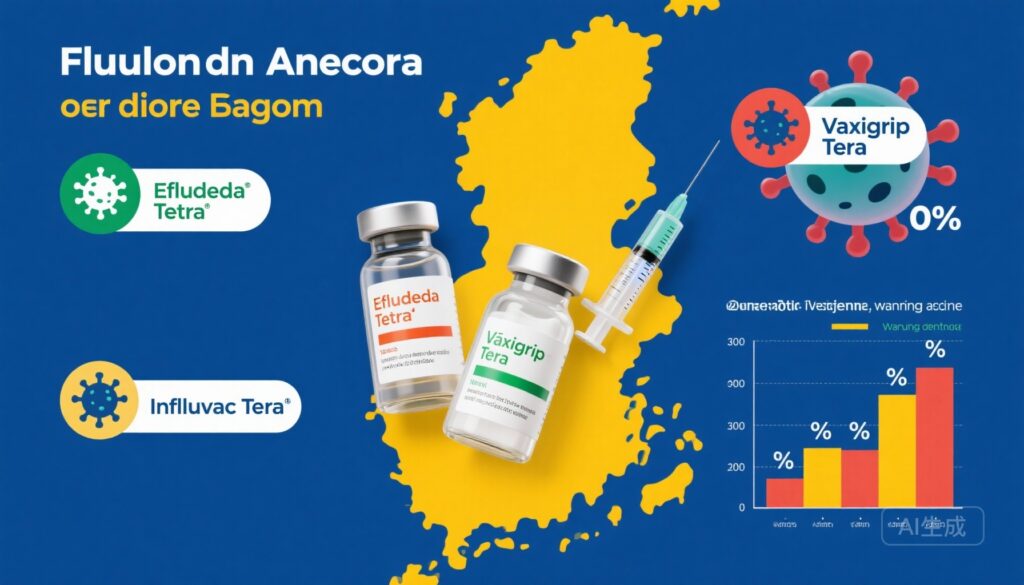Highlights
- First large-scale target trial emulation using linked Nordic registries estimated brand-specific influenza vaccine effectiveness in adults aged ≥65 years during the 2024-2025 season.
- Efluelda Tetra (split virion-high dose) showed the highest vaccine effectiveness (~63%) against influenza-related hospitalization, followed by Fluad Tetra (subunit adjuvanted), highlighting the benefit of enhanced formulations in older adults.
- Overall influenza vaccination reduced hospitalizations by nearly 47%, with a risk difference of up to -99 per 100,000 vaccinated in Denmark, supporting robust public health impact.
- Vaccine effectiveness waned significantly over the 18-week follow-up, decreasing approximately 6.5 percentage points every three weeks, suggesting timing considerations in vaccine administration.
Background
Seasonal influenza remains a major cause of morbidity and mortality globally, particularly among older adults aged 65 years and older. In Nordic countries, the annual influenza vaccination campaign targets this vulnerable population to reduce severe outcomes, including hospitalization and mortality. Despite widespread vaccine coverage, data on the comparative effectiveness of different influenza vaccine brands are limited, yet essential for optimizing vaccine policy and regulatory decisions. Variability in vaccine formulation—dose, adjuvant presence, and virus component structure (split virion vs. subunit)—may influence immunogenicity and clinical protection, particularly in the immunosenescent elderly population.
Key Content
Methodological Advances: Target Trial Emulation Using Nordic Registries
The referenced study by Faksova et al. (2025) utilized target trial emulation, a rigorous epidemiological approach that simulates randomized controlled trials using observational data to reduce biases inherent in non-randomized designs. Nationwide registries from Denmark, Finland, and a Swedish region including vaccination records, laboratory-confirmed influenza outcomes, hospital admissions, and mortality data were linked. Adults aged 65 years and older were matched 1:1 to balance confounding variables, comparing vaccinated individuals to unvaccinated controls. Follow-up extended 18 weeks post-immunization.
Brand-Specific Vaccine Effectiveness Findings
Among 1,164,686 matched pairs (mean age 75.4±7.3 years), the overall vaccine effectiveness (VE) against influenza-related hospitalization reached 46.8% (95% confidence interval [CI] 40.8-52.9). Risk differences per 100,000 vaccinees were -99.3 in Denmark and -21.3 in Finland, underscoring substantial public health benefit.
Brand-specific VE varied:
- Efluelda Tetra (split virion, high-dose): VE 63.4% (95% CI 38.1-88.7%)
- Fluad Tetra (subunit, standard-dose adjuvanted): VE 48.2% (95% CI 40.8-55.6%)
- Vaxigrip Tetra (split virion, standard-dose): VE 43.6% (95% CI 23.7-63.6%)
- Influvac Tetra (subunit, standard-dose): VE 30.6% (95% CI -7.8 to 69.1%)
These data emphasize the potential advantage of enhanced vaccine formulations, including high-dose and adjuvanted vaccines, to improve protection in older adults.
Comparison with Other Evidence on High-Dose Vaccines
The DANFLU-2 randomized controlled trial (Andersen et al., 2025, NEJM) conducted in Denmark evaluated high-dose versus standard-dose influenza vaccines over three seasons, including 2024-2025. Although the primary composite endpoint of hospitalization for influenza or pneumonia did not significantly differ (relative VE 5.9%, 95.2% CI -2.1 to 13.4%), a significant reduction in hospitalization specifically for influenza (relative VE 43.6%, 95% CI 27.5-56.3) was observed with high-dose vaccine, congruent with the observational Nordic cohort findings supporting enhanced-dose vaccine use.
Waning Immunity
Faksova et al. documented VE waning at approximately 6.5 percentage points every 3 weeks post-vaccination, an important consideration for timing vaccination campaigns and potential booster strategies in older adults.
Methodological Considerations: Bias in VE Estimation
Studies using test-negative designs with rapid diagnostic tests may underestimate VE due to misclassification bias (Wong et al., 2025, Int J Epidemiol). The Nordic study’s use of PCR-confirmed outcomes and registry linkage minimizes such biases, lending robustness to findings.
Influenza Vaccination in Immunocompromised Older Adults
Register-based research in Denmark (Hansen et al., 2025, Cancer) suggests influenza vaccination may reduce overall mortality in older cancer patients, particularly those with hematological malignancies, supporting broad vaccination policies in high-risk groups, albeit acknowledging potential confounding.
Expert Commentary
These convergent data reinforce that seasonal influenza vaccination moderately reduces severe influenza outcomes in adults aged 65 years and older. Enhanced formulations, such as high-dose and adjuvanted vaccines (Efluelda Tetra and Fluad Tetra), show superior effectiveness, likely reflecting improved immunogenicity overcoming immunosenescence and pre-existing immunity challenges.
The Danish randomized evidence complements observational registry studies, providing a higher level of evidence while underscoring the difficulty demonstrating significant differences in composite clinical endpoints due to low event rates and background clinical care.
The waning immunity identified stresses the importance of strategic vaccination timing relative to influenza season peaks. Additionally, standard-dose subunit vaccines may offer less consistent protection, and negative lower confidence intervals (as with Influvac Tetra) highlight imprecision and population heterogeneity effects.
Routine use of comprehensive Nordic health registries enables annual monitoring to promptly detect changes in VE by brand, population, and circulating strains to inform regulatory and clinical guidelines. Such real-world data integration is a model for evidence-based vaccine policy worldwide.
Limitations include potential residual confounding despite matched designs, the absence of data from all Swedish regions, and incomplete accounting for prior influenza infection or immunity history.
Conclusion
The 2024-2025 Nordic registry-based target trial emulation study provides critical, brand-specific influenza vaccine effectiveness estimates in older adults, confirming moderate protection against severe influenza-related outcomes. High-dose split virion (Efluelda Tetra) and adjuvanted subunit (Fluad Tetra) vaccines demonstrated superior effectiveness, endorsing their preferential use in the elderly population.
These findings advocate for tailored influenza vaccine strategies prioritizing enhanced formulations for older adults and emphasize the role of continuous, large-scale registry surveillance to support adaptive immunization policies.
Future research should explore optimal vaccination timing, booster needs in the elderly, and VE in immunocompromised subpopulations, leveraging Nordic data infrastructure.
References
- Faksova K et al. Brand-specific influenza vaccine effectiveness in three Nordic countries during the 2024-2025 season: a target trial emulation study based on registry data. Lancet Reg Health Eur. 2025 Nov 3;60:101518. doi: 10.1016/j.lanepe.2025.101518. PMID: 41255775; PMCID: PMC12621552.
- Andersen L et al. High-Dose Influenza Vaccine Effectiveness against Hospitalization in Older Adults. N Engl J Med. 2025 Aug 30. doi: 10.1056/NEJMoa2509907. PMID: 40888720.
- Wong N et al. Bias in control selection associated with the use of rapid tests in influenza vaccine effectiveness studies. Int J Epidemiol. 2025 Jun 11;54(4):dyaf089. doi: 10.1093/ije/dyaf089. PMID: 40574484.
- Hansen K et al. Influenza vaccine effectiveness in immunocompromised patients with cancer: A Danish nationwide register-based cohort study. Cancer. 2025 Jan 1;131(1):e35574. doi: 10.1002/cncr.35574. PMID: 39306693.


